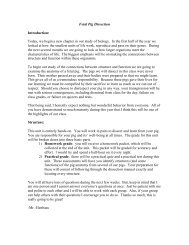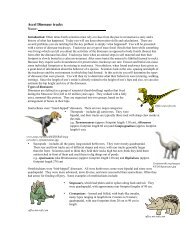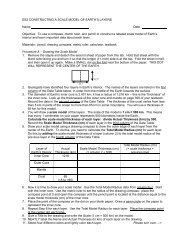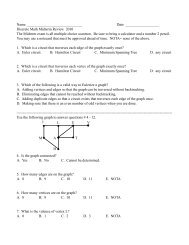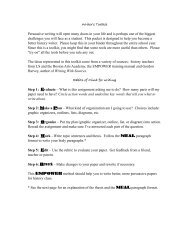Prohibition Powerpoint - LS Home Page
Prohibition Powerpoint - LS Home Page
Prohibition Powerpoint - LS Home Page
- No tags were found...
Create successful ePaper yourself
Turn your PDF publications into a flip-book with our unique Google optimized e-Paper software.
The <strong>Prohibition</strong> Era, 1919-1933
History of theTemperance Movement• The Temperance Movement beganin the U.S. in the early 1800s butgained strength in the late 1800s.• By 1830, the average American overthe age of 15 drank the equivalentof 88 bottles of whiskey per year!• Temperance advocates, womenincluded, used social, educational,and political tactics to push forgovernment control of liquor.– Supported by churches and businessowners who faced poor workerproductivity and absenteeism.
• By 1918, more than ¾ of people in the U.S. lived in drystates or counties.
• It was not until WWI that antisaloonadvocates were able toassociate <strong>Prohibition</strong> withpatriotism.– A ban on alcohol would boostsupplies of important grains, such asbarley.– Argued that it was wrong of someAmericans to enjoy alcohol while thecountry’s young men were at war.– Anti-German hysteria aided<strong>Prohibition</strong> crusaders.• “We have German enemies across the water, wehave German enemies in this country too. Andthe worst of all our German enemies, the mosttreacherous, the most menacing are Pabst,Schlitz, Blatz and Miller.”
The <strong>Prohibition</strong> Era, 1919-1933• In 1919, Congress passed theVolstead Act, known as the National<strong>Prohibition</strong> Act, banning brewingand selling beverages containingmore than ½ of 1% alcohol.• In June 1919, the 36 th state ratifiedthe 18 th Amendment, whichprohibited the manufacture, sale,and transport of intoxicating liquors.(However, the country had, for allpractical purposes, been dry since1917.)
Amendment XVIII, U.S. Constitution • Section 1.– After one year from the ratification of this article the manufacture,sale, or transportation of intoxicating liquors within, the importationthereof into, or the exportation thereof from the United States andall territory subject to the jurisdiction thereof for beverage purposesis hereby prohibited.• Section 2.– The Congress and the several States shall have concurrent power toenforce this article by appropriate legislation.• Section 3.– This article shall be inoperative unless it shall have been ratified asan amendment to the Constitution by the legislatures of the severalStates, as provided in the Constitution, within seven years from thedate of the submission hereof to the States by the Congress.Passed December 18, 1917. Ratified January 16, 1919.
This Detroit scene was repeated across the nation, January, 16, 1920, as shoppers stocked up on thelast day before <strong>Prohibition</strong> took effect.
• In his book The Devaluing of America, WilliamBennett, former director of the Office ofNational Drug Control Policy under PresidentGeorge H.W. Bush, said:– “Contrary to myth, there is no evidence that<strong>Prohibition</strong> caused any big increases in crime. The realfacts are these: As a result of <strong>Prohibition</strong>, 180,000saloons were shut down, and 1,800 breweries went outof business. In ten years of <strong>Prohibition</strong>, the death ratedue to alcohol decreased 42 percent, the death ratedue to cirrhosis of the liver decreased by 70 percent,crime decreased by 54 percent, and insanity decreasedby 66 percent.”
Negative Outcomes of <strong>Prohibition</strong>• Legislation showed the difficulty of using the lawto promote moral reform. People who wanted todrink found a way.
Women (middle andupper class women)began to drink in publicfor the first time.
Negative Outcomes of <strong>Prohibition</strong> (cont.)• Speakeasies replaced saloons, people consumed bathtubgin, home brews, and many strange, dangerousconcoctions.• Bartenders invented the cocktail in an effort to disguisethe poor quality of liquor.– Popular drinks of the day included the Sidecar, the Highball,the French 75, and the Bees Knees (which included aspoonful of honey, lemon, and a splash of orange juice tomask the flavor of bathtub gin.)
Grandpa Was A Bootlegger• My Grandpa was a bootlegger. In fact, his father was a stern, honest farmer. NowGrandpa, he was the black sheep of the family, a bit of a rounder by all accounts, butfriendly, outgoing and generally loved by most of his acquaintances. Well, the Revenueagents didn’t like him much … he thoroughly enjoyed being a bootlegger, and reveled inoutrunning or outmaneuvering the ‘revenuers’. A family folklore surrounded those years,that Grandpa went to prison for bootlegging. A little digging brought up the prison record,which listed the charges as ‘petty larceny’, for stealing a barrel of gas. When his daughterShirley was asked about this, she chuckled and said, ‘Oh yeah! Dad used to laugh about that.He was delivering a barrel of whiskey in Phoenix when the law started chasing him.Realizing he would be caught, he raced into a gas station, dumped the whiskey, grabbed abarrel of gas and raced out. He was stopped shortly after, and the revenue agents mainlywanted his list of customers. Well, that list included certain judges, attorneys, even theattorney general, and he wasn’t about to give them up. Enraged by his lack of cooperation,the agents saw to it that he was sent to prison for stealing 25 gallons of gas, worth less than5 dollars.’ He spent a year there, in 1924, for a petty offense, not a felony! Needless to say,there were many well placed politicians and professionals that deeply appreciated hisdiscretion, and they remained his friends all of his life.
• To enforce the 18 th Amendment, a <strong>Prohibition</strong> Bureau was formedin the Treasury Department with the task to enforce the law. Theirjobs was to patrol 18,700 miles of coastline, as well as inlandborders, track down illegal stills, monitor highways for truckloads ofillegal alcohol, and oversee all industries that legally used alcohol tomake sure that none was diverted for illegal purposes.• The <strong>Prohibition</strong> Bureau employed approximately 1,500 federalagents and local police, creating a major enforcement challenge.Most field enforcement agents were poorly paid and therefore easyto bribe.• To exacerbate the problem, the enforcement effort received littlesupport from the federal government, both in terms of lack offunds as well as little cooperation from other government agenciesand officials.
<strong>Prohibition</strong> agents examine liquorconfiscated from a captured rum runner,1924Patrolling thousands of milesof borders to stop smugglingwas nearly impossible, as waslocating and shutting down thenumerous stills and speakeasiespopping up around thecountry.By 1925, in New York City alone there wereanywhere from 30,000 to 100,000 speakeasyclubs.
The demand foralcoholoutweighed thedemand forsobriety. Peoplefound clever waysto evade<strong>Prohibition</strong>agents. Theycarried hip flasks,hollowed canes,false books, andthe like.<strong>Home</strong>made liquor still, 1920Many Americans experimented with homemade stillsto make alcohol for home consumption or to sellillegally during <strong>Prohibition</strong>
"Jurors Go On Trial, Drank Up Evidence,” NYT, Jan. 7, 1928In the same court where they heard testimony last Friday afternoon that acquitted a liquordefendant eight jurors went on trial today before Municipal Judge Ambrose to show causewhy they should not be suspended from further jury service for drinking the evidence in thecase.The ninth member of the jury, A. A. Huelester, collapased soon after the Magistrate had assailedthe jurors vigorously for a "breach of conduct." Mr. Huelesteer was removed to his homeon orders of a county jail physician who examined him. Though earlier in the day the Judgehad discharged nine members of the jury when they refused to take the stand and denyconsuming virtually all of the evidence against George Beven, hotel clerk. He finallyappointed attorneys to represent them.Sworn to tell the truth, the eight jurors took the stand and gave their stories as to whathappened in the jury room during the three hours it took to determine the case of Beven,who was acquitted of violation of the State <strong>Prohibition</strong> act. Judge Ambrose heard thecharges of drinking the evidence in silence. The jurors all admitted drinking the pint ofliquor which was the prosecution's chief exhibit against Beven. All denied it was consumedwithout an honorable motive. They stated it was sampled to determine whether it was ofalcoholic content and actually constituted a violation of the liquor law.The magistrate considered the pleadings of the two lawyers appointed by him to get at the factsof the case. He agreed to go over the circumstances again in his mind and decide Monday at9:30 A.M. whether to reinstate the nine accused jurors.
Negative Outcomes of <strong>Prohibition</strong> (cont.) • <strong>Prohibition</strong> agents devoted much timeand energy to the task of combatingthe big city gangs that grew rich andpowerful off of bootlegging.– Bootlegging rings were tied to organizedcrime in many cities and funded.– Mob operations made millions from theillegal sale & manufacturing of alcohol.– Al Capone (Chicago) was the most famousunderworld figure – power and wealth wastied to the sale of illegal alcohol. Hisorganization grossed an estimated $60million in 1927 (which is more 750 million intoday’s money)! (Most of the profits camefrom distributing beer.)– In many cases, cops were aware of what wasgoing on and illegally accepted bribes fromthe mob to look the other way.
Movement toRepeal the 18 thAmendment• Many supporters of <strong>Prohibition</strong> came to favor its repeal because:– It stimulated too much illegal activity– It did not seem to be worth the social, economic and political costs– The closing of breweries, distilleries and saloons led to the elimination ofthousands of jobs.– <strong>Prohibition</strong> led to unintended consequences such as declining profits inrestaurants, theaters, and other entertainment industries.– In NY, almost 75% of the state’s revenue was derived from liquor taxes.– <strong>Prohibition</strong> cost the federal govt. a total of $11 billion in lost tax revenue, andcost over $300 million to enforce.
The Great Depression struck the final blow against <strong>Prohibition</strong>. Here,marchers in Detroit bear signs reading, "Beer for Taxation, Jobs forMillions,” 1930.
The End of <strong>Prohibition</strong> (1933)• As part of FDR’s New Deal legislation, the Beer-WineRevenue Act legalized beer that had an alcohol contentof 3.2% and light wines and levied a tax on both(revenue generator during the Great Depression.)• The 21 st Amendment, ratified Dec. 5, 1933, repealedthe 18 th Amendment and ended the <strong>Prohibition</strong>experiment.



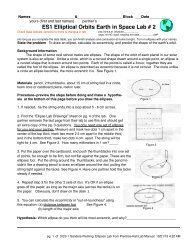


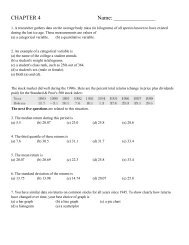
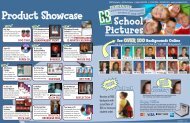

![';1asAu ro; las I sgeo8 leuo!]eslanuol aql utelqo o1 palenttouJ ue I ...](https://img.yumpu.com/49072782/1/190x221/1asau-ro-las-i-sgeo8-leuoeslanuol-aql-utelqo-o1-palenttouj-ue-i-.jpg?quality=85)

